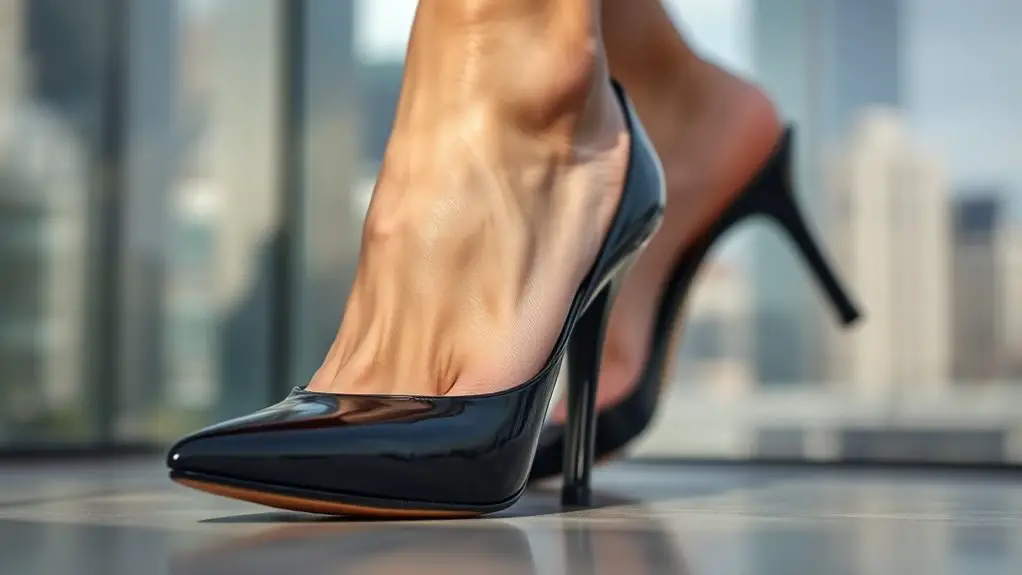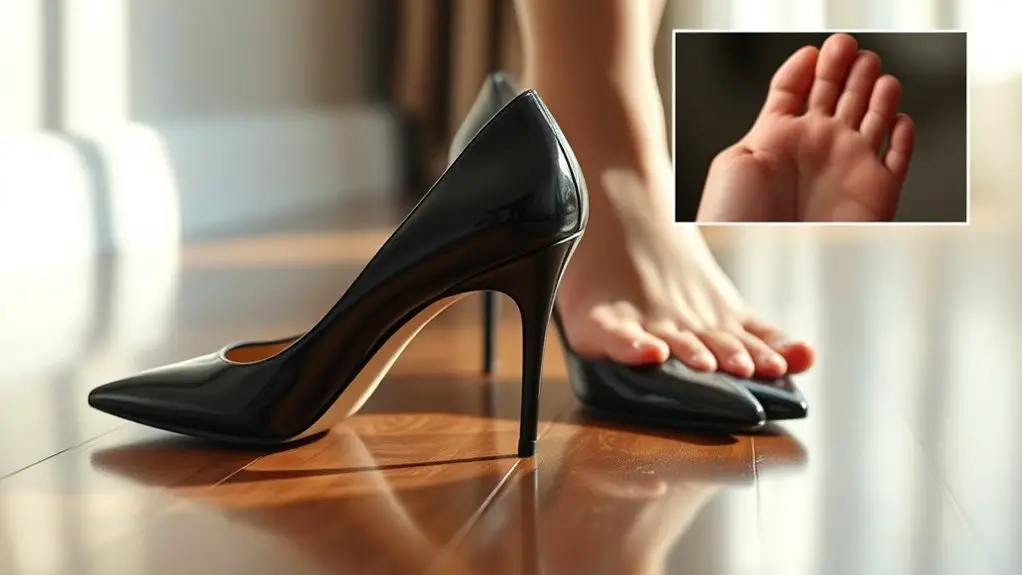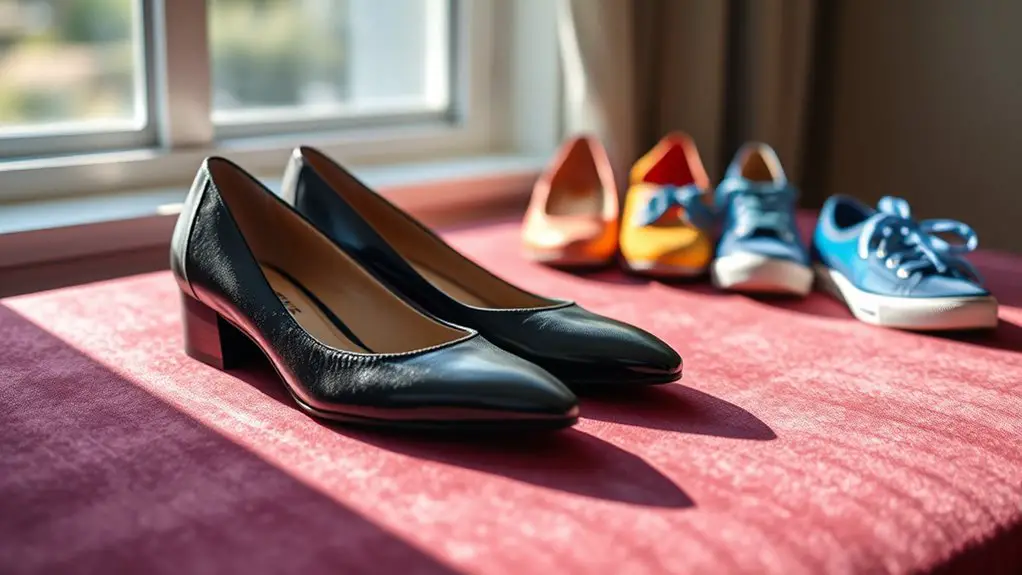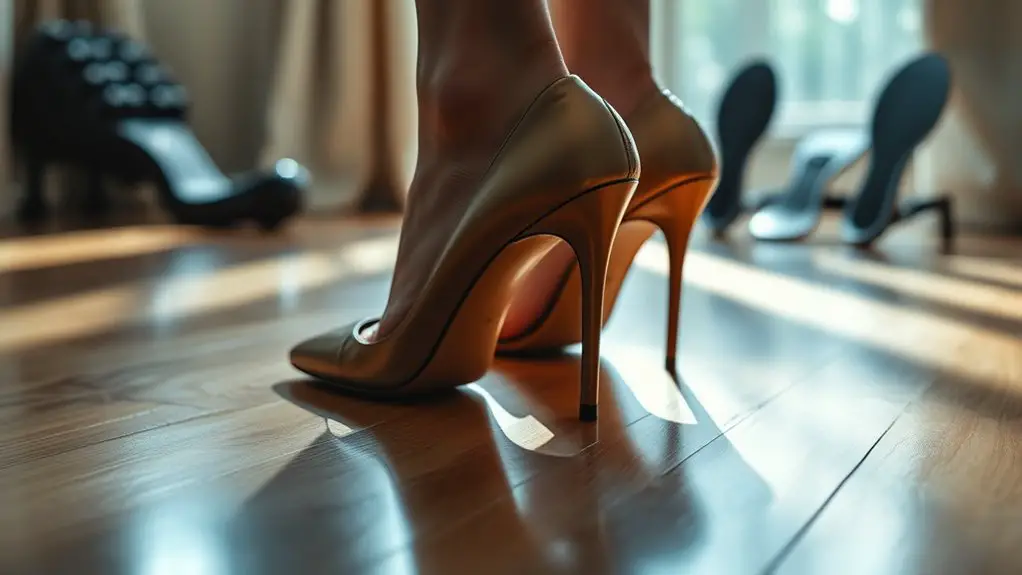Wearing high heels can indeed cause nerve damage, often leading to symptoms like tingling, numbness, or burning sensations in your feet. The design of high heels places excessive pressure on specific areas, compressing nerves and potentially resulting in painful conditions. Additionally, wearing them frequently can contribute to various foot problems, such as bunions and plantar fasciitis. To learn more about protecting your foot health and finding stylish alternatives, continue exploring the topic.
Understanding Nerve Damage and Its Symptoms

Nerve damage, often referred to as neuropathy, can manifest in various ways, affecting your ability to feel and move. One common cause is nerve compression, which occurs when surrounding tissues put pressure on nerves, leading to disruptions in their function. You may experience symptoms like tingling, numbness, or burning sensations, particularly in your extremities. Sensory loss is another significant symptom, where you may find it difficult to feel sensations such as touch, temperature, or pain. This decreased sensitivity can make you more prone to injuries, as you might not notice cuts or abrasions. Over time, if left untreated, nerve damage can progress to motor symptoms, causing weakness or coordination issues. Understanding these symptoms is vital for early intervention and management. If you’re experiencing any of these signs, it’s essential to consult a healthcare professional to assess your condition and explore appropriate treatment options.
The Anatomy of the Foot and How Heels Affect It
When considering how high heels impact the foot, it is crucial to understand the anatomy involved. The foot structure comprises bones, muscles, ligaments, and tendons, all working together to provide stability and mobility. High heel height alters this balance, placing excessive pressure on specific areas.
High heels disrupt the foot’s natural anatomy, leading to increased pressure and potential discomfort.
Here are key components affected by high heels:
- Metatarsals: The long bones in your foot that bear weight under pressure, risking injury.
- Arch: Elevated heels can strain the arch, leading to discomfort and potential structural changes.
- Achilles tendon: Shortening of this tendon can occur with consistent heel use, affecting mobility.
- Nerves: High heels can compress nerves, especially those in the ball of the foot, leading to pain or numbness.
Understanding these anatomical factors can help you make informed decisions about heel height and foot health.
Common Foot Problems Linked to High Heel Usage

Many people who regularly wear high heels experience common foot problems that can greatly impact their daily lives. One prevalent issue is bunions formation, which occurs when the big toe deviates toward the other toes, often exacerbated by the narrow toe box of high heels. This misalignment can lead to painful swelling and difficulty in wearing shoes.
Another common condition linked to high heel usage is plantar fasciitis. The elevated heel position places excessive stress on the plantar fascia, a thick band of tissue that runs along the bottom of your foot. Over time, this can result in inflammation and sharp heel pain, particularly noticeable during the first steps after waking up or after prolonged periods of sitting.
These foot problems not only affect comfort but can also hinder mobility, making it essential to recognize the risks associated with high heel wear.
Tips for Reducing the Risk of Nerve Damage
High heels can exacerbate a variety of foot issues, including nerve damage, particularly in the lower extremities. To minimize these risks, consider the following tips:
- Footwear Choices: Opt for shoes with lower heels and wider toe boxes, which provide better support and reduce pressure on nerves.
- Limit Wear Time: Try to restrict the duration you wear high heels. Alternate with comfortable footwear throughout the day.
- Stretching Exercises: Incorporate stretching exercises for your calves and feet. These can alleviate tension and improve flexibility, reducing nerve strain.
- Foot Care Routine: Regularly massage your feet and check for any signs of discomfort or nerve issues. Early intervention can prevent further complications.
Alternatives to High Heels for Style and Comfort

While you may love the elegance that high heels offer, there are numerous stylish alternatives that can provide both comfort and support. Stylish flats and comfortable wedges are excellent options for maintaining a chic appearance without sacrificing foot health.
| Type of Shoe | Features | Style Tips |
|---|---|---|
| Stylish Flats | Low profile, cushioned insoles | Pair with tailored trousers or casual dresses |
| Comfortable Wedges | Slight elevation, arch support | Ideal with skirts or summer dresses |
| Loafers | Slip-on, versatile | Great for work or casual outings |
| Ankle Boots | Supportive structure, chic | Perfect for changing seasons |
Frequently Asked Questions
Can Wearing Heels Affect Balance and Coordination?
“All that glitters isn’t gold.” Wearing heels can considerably impact your balance, leading to coordination challenges. The elevation shifts your center of gravity, making you more prone to instability and increasing the risk of falls.
How Long Can You Safely Wear Heels Without Damage?
To guarantee heel comfort, aim for a safe duration of two to four hours in heels. Prolonged wear can lead to discomfort and potential foot issues, so it’s essential to monitor your feet’s response.
Do Different Heel Heights Cause Different Nerve Issues?
Imagine your nerves trapped like a bird in a cage. Different heel heights can exacerbate nerve compression, with higher heels often increasing pressure on nerves, potentially leading to various nerve issues. Be mindful of heel height effects.
Are Certain Foot Shapes More Prone to Nerve Damage From Heels?
Certain foot shapes, like high arches or wide feet, may increase nerve susceptibility when wearing heels. These shapes can compress nerves more severely, leading to a higher risk of discomfort and potential nerve damage over time.
Can Nerve Damage From Heels Be Reversed?
Approximately 30% of individuals experience nerve issues from high heels. While nerve regeneration can occur, it may take months. Consider footwear alternatives to alleviate pressure and promote healing, as prolonged damage can hinder recovery.



